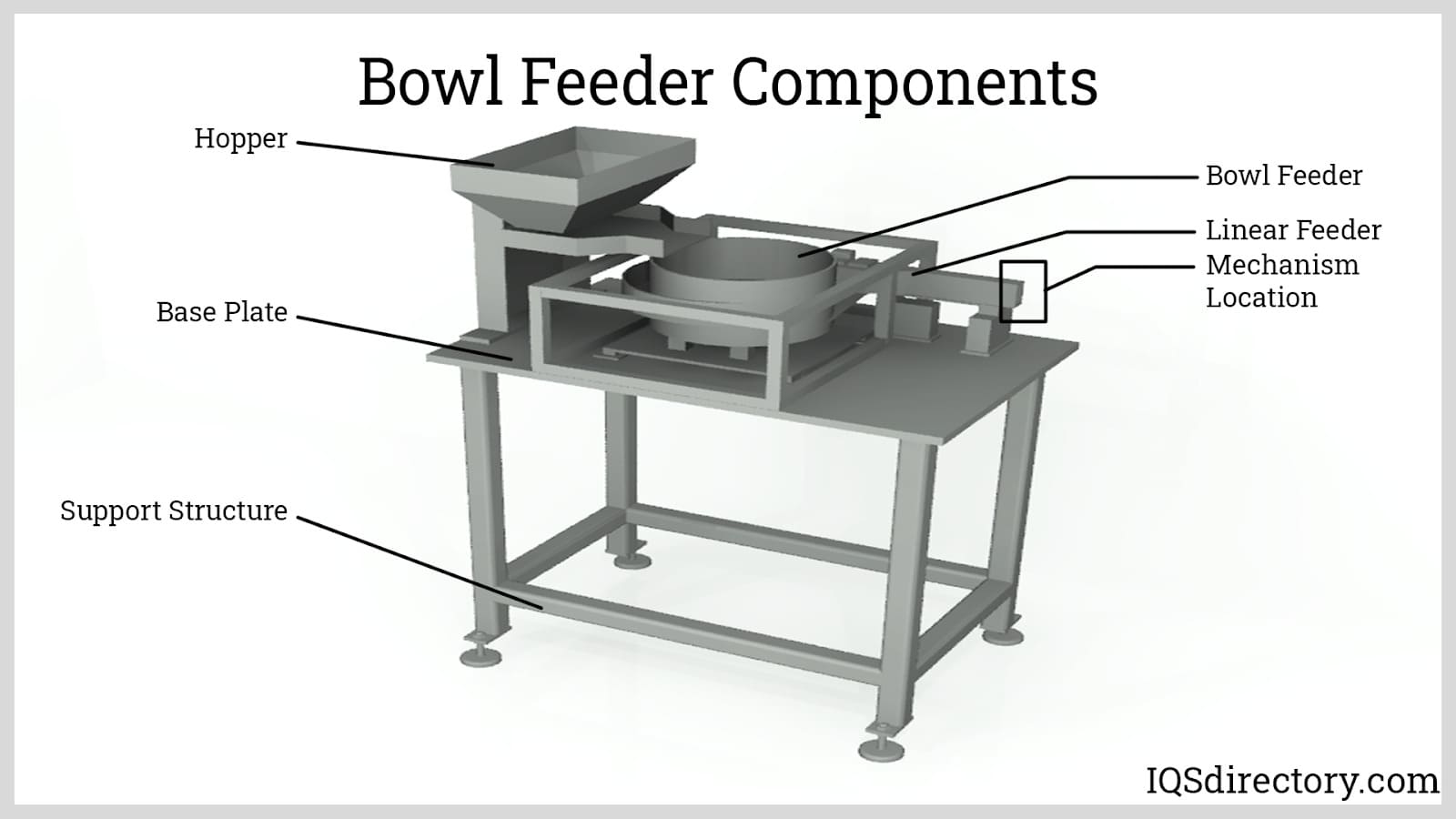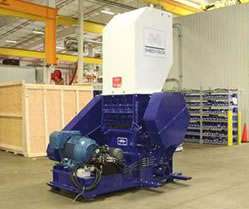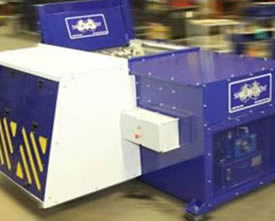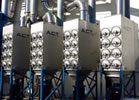Vibratory feeders are automated devices used in various industries for efficient material handling and processing. They utilize vibration to transport and feed a wide range of materials, such as solid components, bulk solids, or even delicate items, ensuring a smooth and controlled flow. These feeders find application in diverse sectors, including manufacturing, food processing, pharmaceuticals, mining, and more. In the manufacturing industry, vibratory feeders are employed for precise assembly processes, aiding in the smooth and accurate feeding of small parts or components. Read More…
ERIEZ is a global manufacturer of an entire range of vibratory feeders and related machinery. We serve all the process industries, including food, chemical, pharmaceutical, ceramics, glass, packaging, metalworking, minerals processing and others.

Rodix manufactures vibratory feeder controls, inline track drives, drive bases, & bulk storage hoppers for part feeding systems. Our line of vibratory feeder controls feature variable amplitude, variable frequency, line-voltage compensation, UL/cUL Listed, CE Marked, and more. We have experience working with machine integrators, vibratory feed system builders, and manufacturers.

PPM Technologies Holdings, LLC is an innovative industry leader in the vibratory feeder industry. Our main focus has always been to provide our customers with high-quality products with the exact specifications for their needs. With our wide range of products, we are able to serve various industries.

Vibratory bowl feeders are our specialty! For four decades we have been offering products that are guaranteed to last! Our vibratory bowl feeders come with multiple sound abatement options, standard and custom control packages and many other options for your convenience of choice! Visit our website today or get in touch with our customer service representatives by email or telephone today!

Parts Feeders provides industries with quality parts feeders, feeder bowls and other vibratory feeder equipment. We provide a wide range of products and services to ensure that you, the customer, receive the best in quality and reliability. A leader in the industry since 1957.

More Vibratory Feeder Manufacturers
In the food processing sector, they play a crucial role in conveying and aligning delicate fruits, nuts, or food items during packaging or processing operations. Vibratory feeders are also widely used in mining operations to efficiently transport and separate bulk materials, optimizing productivity and reducing manual labor. Their versatility and reliability make them indispensable tools in modern material handling, offering increased productivity, reduced manual labor, and improved efficiency across industries.
Components and Functioning of Vibratory Feeders
Vibratory feeders consist of several key components that work together to create a functioning system. The vibrating drive unit is at the heart of the feeder and generates controlled vibrations. It typically includes an electric motor with an eccentric weight or an electromagnetic drive that produces the required oscillating motion. This motion is transmitted to the tray or trough, which holds and transports the materials. The tray is often customized to suit the specific application, ensuring an optimal flow of materials. To maintain stability and isolate vibrations, springs are employed. These springs provide support and dampen any excess vibrations, ensuring a smooth operation. The support structure, meanwhile, provides a solid foundation for the feeder, maintaining its stability and preventing any unwanted movement. Together, these components create a functioning vibratory feeder that efficiently and reliably transports materials. Whether it’s aligning small parts, conveying bulk solids, or handling fragile items, the synchronized interaction of these components ensures a consistent and controlled flow, enhancing productivity and minimizing material handling challenges.
Varieties of Vibratory Feeders
Vibratory feeders come in various designs and configurations, each suited for specific applications. One popular variation is the bowl feeder, which utilizes a conical-shaped bowl that vibrates, causing the parts within it to move upward along spiral tracks. This design is commonly used for orienting and feeding small parts or components, such as screws or electronic chips, in assembly lines. Another type is the tube feeder, frequently employed in the pharmaceutical industry. Tube feeders utilize a tube or cylinder that vibrates, gently transporting delicate tablets or capsules without damaging them. Linear feeders, on the other hand, use a linear motion to transport items in a straight line. This design is particularly useful in applications requiring precise positioning, such as packaging or inspection processes. Additionally, there are specialized designs for specific applications, such as hopper feeders for bulk material handling or step feeders for sequential part feeding. Each variety of vibratory feeder offers unique features and advantages, catering to the specific requirements of different industries and applications.
Rules, Regulations, and Agencies
The creation and use of vibratory feeders within the United States are subject to regulations set forth by various government agencies. One such agency is the Occupational Safety and Health Administration (OSHA), which establishes workplace safety standards. OSHA ensures that manufacturers and users of vibratory feeders comply with safety regulations to protect workers from hazards associated with operating and maintaining these devices., such as potential pinch points, and risks associated with manual interaction during maintenance or troubleshooting. Additionally, the Environmental Protection Agency (EPA) regulates the environmental impact of vibratory feeders, particularly concerning noise emissions and potential pollution. Compliance with these regulations is crucial for manufacturers to meet safety and environmental standards, avoid penalties, and maintain a safe working environment. It is essential for manufacturers and users of vibratory feeders to stay informed about the latest rules and regulations to ensure proper compliance and mitigate any potential risks or legal issues.
Benefits of Vibratory Feeders
Vibratory feeders offer a wide range of benefits that contribute to improved efficiency, productivity, and overall operational effectiveness. One key advantage is their ability to provide a controlled and consistent material flow, ensuring a steady supply to downstream processes and minimizing disruptions. This leads to increased productivity as it eliminates the need for manual feeding and reduces downtime. The versatility of vibratory feeders, meanwhile, allows them to handle various materials, from small components to bulk solids, making them adaptable to different industries and applications. They can gently handle delicate or fragile items without causing damage, maintaining the integrity of the products being processed. Moreover, vibratory feeders offer precise and adjustable feeding rates, allowing for accurate control over the flow of materials. This precision minimizes waste, enhances accuracy in assembly processes, and ensures high product quality. Additionally, vibratory feeders are often low-maintenance, with simple designs and few moving parts, reducing the need for frequent repairs or replacements. They are durable, reliable, and easy to clean, resulting in reduced operational costs. Overall, the benefits of vibratory feeders encompass increased productivity, improved efficiency, enhanced product quality, versatility in material handling, and cost-effectiveness, making them an essential component in a wide range of industries.
Limitations of Vibratory Feeders
While vibratory feeders offer numerous advantages, they also have certain limitations that should be considered. One limitation is their suitability for handling materials that are prone to clumping, bridging, or jamming. These feeders may face challenges when dealing with cohesive or sticky materials that tend to stick to the trough or tray, impeding the smooth flow of material. Additionally, some materials may cause excessive wear and tear on the feeder components, leading to maintenance issues and potential downtime. Vibratory feeders also have size and weight limitations, which may restrict their application in handling larger or heavier materials. It is important to assess the characteristics of the materials being handled and consider these limitations when selecting or designing a vibratory feeder system. Mitigating these limitations often requires customization, such as employing specialized coatings, adjusting tray designs, or incorporating additional features to address specific material challenges.
Overcoming Limitations
Manufacturers of vibratory feeders are actively working to overcome the limitations associated with their use. They are constantly researching and developing innovative solutions to enhance the performance and functionality of these feeders. One approach is the development of improved surface coatings and lining materials that can reduce the adherence of sticky or cohesive materials, minimizing the risk of clogging or bridging. Customized tray designs with specialized features, such as angled surfaces or adjustable gates, are being implemented to facilitate the smooth flow of challenging materials. Manufacturers are also focusing on advancements in control systems, allowing for more precise adjustments of vibration intensity, frequency, and timing to optimize the handling of different materials. Furthermore, the integration of advanced monitoring and diagnostic technologies enables real-time feedback and predictive maintenance, minimizing downtime and improving overall operational efficiency. These concerted efforts by manufacturers aim to enhance the reliability, versatility, and performance of vibratory feeders, enabling them to overcome limitations and meet the evolving needs of various industries.
Choosing the Right Vibratory Feeder
Choosing the right vibratory feeder for a specific application requires careful consideration of several factors. To start, the characteristics of the materials being handled must be evaluated, including their size, shape, density, and flow properties. It is essential to select a feeder that can effectively handle the specific material requirements. The desired feed rate, or the amount of material to be processed per unit of time, should also be determined. Additionally, the environmental conditions in which the feeder will operate, such as temperature, humidity, or the presence of corrosive substances, should be taken into account to ensure the feeder’s durability and longevity. Consulting with experts and manufacturers, conducting thorough testing, and seeking recommendations based on industry best practices can provide valuable insights in selecting the appropriate feeder. It is also crucial to consider the feeder’s reliability, ease of maintenance, and availability of spare parts and technical support. By carefully evaluating these factors, one can choose a vibratory feeder that meets the specific requirements of their application, ensuring optimal performance and productivity.
Integration with Automation Systems
Vibratory feeders play a crucial role in the integration of automation systems, enabling efficient material handling and seamless workflow. Integrating vibratory feeders with automation systems, such as robotic assembly lines or PLC-controlled processes, allows for synchronized and precise feeding of materials. By incorporating sensors and feedback mechanisms, the automation system can communicate with the vibratory feeder to regulate the flow of materials based on real-time requirements. This integration enables a higher level of control and adaptability, ensuring optimal production rates and reducing errors. Vibratory feeders can also be programmed to synchronize with other machinery, triggering the feeding process at specific intervals or in response to signals from the automation system. This synchronization ensures a smooth and continuous material flow, enhancing the overall efficiency and productivity of the automated process. The integration of vibratory feeders with automation systems not only improves accuracy and speed but also reduces manual labor, allowing operators to focus on other critical tasks.
Maintenance and Troubleshooting
Proper maintenance and troubleshooting practices are essential for ensuring the optimal performance and longevity of vibratory feeders. Regular maintenance includes inspecting the feeder as part of a scheduled maintenance routine for any signs of wear, damage, or loose components, and addressing them promptly. Additionally, routine cleaning to remove debris and build-up from vibratory feeders should ideally be performed regularly, depending on the specific application and the accumulation of material, and can range from daily to weekly or as needed. Lubrication of moving parts, such as bearings or drive mechanisms, should be done according to the manufacturer’s recommendations. Additionally, monitoring the vibrations and noise levels of the feeder can help detect any abnormalities or potential issues. Troubleshooting involves identifying and resolving common problems that may arise during operation, such as material blockages, incorrect feeding rates, or irregular vibrations. It is important to consult the feeder’s manual and follow the recommended troubleshooting procedures. In case of more complex issues, involving a trained technician or contacting the manufacturer’s support team may be necessary. Regular maintenance and prompt troubleshooting practices ensure optimal performance, minimize downtime, and extend the lifespan of vibratory feeders, thereby maximizing their efficiency and productivity in material handling operations.
Future Outlook
The future of vibratory feeders holds immense potential for further advancements and developments. With ongoing technological innovations, these feeders are expected to become more intelligent and adaptable. Integration of advanced control systems, such as artificial intelligence and machine learning algorithms, could enable feeders to analyze and respond to changing material characteristics in real-time, optimizing performance and efficiency. Additionally, advancements in sensor technology may enhance the ability to monitor and adjust parameters, ensuring precise and reliable feeding. The development of novel materials and surface coatings would address wear and maintenance challenges, increasing the lifespan and reliability of vibratory feeders. Furthermore, the integration of Industry 4.0 concepts could enable connectivity and data exchange, facilitating predictive maintenance and remote monitoring. As industries continue to prioritize automation, productivity, and efficient material handling, vibratory feeders are poised to play a pivotal role in shaping the future of manufacturing, processing, and material handling, offering enhanced performance, flexibility, and improved integration with advanced technologies.
Choosing the Right Vibratory Feeder Manufacturer
To ensure you have the most positive outcome when purchasing vibratory feeders from a vibratory feeder manufacturer, it is important to compare several companies using our directory of vibratory feeder manufacturers. There, each vibratory feeder manufacturer has a business profile page highlighting their areas of experience and capabilities, along with a contact form to directly communicate with the supplier for more information or to request a quote. Review each vibratory feeder manufacturer business website using our patented website previewer to quickly learn what each company specializes in. Then, use our simple RFQ form to contact multiple vibratory feeder businesses with the same form.
Check out our Recycling Equipment website
Check out our Vacuum Cleaners website







 Balers
Balers Compactors
Compactors Granulators
Granulators Grapplers
Grapplers Metal Shears
Metal Shears Pulverizers
Pulverizers Separators
Separators Shredders
Shredders Vibratory Feeders
Vibratory Feeders Castings & Forgings
Castings & Forgings Bulk Material Handling
Bulk Material Handling Electrical & Electronic Components
Electrical & Electronic Components Flow Instrumentation
Flow Instrumentation Hardware
Hardware Material Handling Equipment
Material Handling Equipment Metal Cutting Services
Metal Cutting Services Metal Forming Services
Metal Forming Services Metal Suppliers
Metal Suppliers Motion Control Products
Motion Control Products Plant & Facility Equipment
Plant & Facility Equipment Plant & Facility Supplies
Plant & Facility Supplies Plastic Molding Processes
Plastic Molding Processes Pumps & Valves
Pumps & Valves Recycling Equipment
Recycling Equipment Rubber Products & Services
Rubber Products & Services